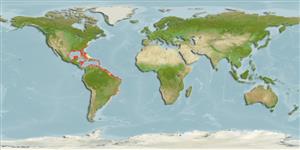Environment: milieu / climate zone / depth range / distribution range
Ecología
marino; salobre asociado a arrecife; rango de profundidad ? - 48 m (Ref. 9710). Subtropical; 42°N - 35°S, 98°W - 34°W
Western Atlantic to Southwest Atlantic: Rhode Island, USA to southeastern Brazil.
Length at first maturity / Tamaño / Peso / Age
Maturity: Lm 10.8 range ? - ? cm
Max length : 38.8 cm TL macho / no sexado; (Ref. 26340); common length : 20.0 cm TL macho / no sexado; (Ref. 3821); peso máximo publicado: 400.00 g (Ref. 5217)
Espinas dorsales (total) : 0; Radios blandos dorsales (total) : 11 - 12; Espinas anales: 0; Radios blandos anales: 11. Greenish above, pale yellow to white below; back has series of pale lines and arcs suggesting concentric circles with intersecting lines. No other puffer has this color pattern (Ref. 26938).
Commonly found in bays, tidal creeks and protected coastal waters, especially on seagrass beds, and in brackish water. Rare or absent on coral reefs. Does not form schools, but may form huge aggregates. Hides in the sand when frightened (Ref. 9710). Feeds mainly on bivalves, gastropods, foraminiferans and several other benthic invertebrates specially crustaceans, which it crushes with its powerful teeth (Ref. 35237). To ward off predators, it inflates itself like a balloon. Highly toxic; used to poison cats and dogs (Ref. 2861).
Spawning season is from late spring to early fall at Biscayne Bay, Florida. Mean length at first maturity is over 13 cm TL.
Robins, C.R. and G.C. Ray, 1986. A field guide to Atlantic coast fishes of North America. Houghton Mifflin Company, Boston, U.S.A. 354 p. (Ref. 7251)
IUCN Red List Status (Ref. 130435: Version 2024-1)
Threat to humans
Poisonous to eat (Ref. 3821)
Human uses
Pesquerías: sin interés
Herramientas
Special reports
Download XML
Fuentes de Internet
Estimates based on models
Preferred temperature (Ref.
123201): 22.9 - 28, mean 25.6 °C (based on 472 cells).
Phylogenetic diversity index (Ref.
82804): PD
50 = 0.5000 [Uniqueness, from 0.5 = low to 2.0 = high].
Bayesian length-weight: a=0.02089 (0.01739 - 0.02511), b=2.93 (2.88 - 2.98), in cm total length, based on LWR estimates for this species (Ref.
93245).
Nivel trófico (Ref.
69278): 3.4 ±0.41 se; based on food items.
Generation time: 2.2 ( na - na) years. Estimated as median ln(3)/K based on 2
growth studies.
Resiliencia (Ref.
120179): Bajo, población duplicada en un tiempo mínimo de 4.5-14 años (K=0.51; rel. fec=1.146 eggs/ g body weight).
Fishing Vulnerability (Ref.
59153): Low vulnerability (22 of 100).
Nutrients (Ref.
124155): Calcium = 32.1 [11.0, 104.4] mg/100g; Iron = 0.721 [0.352, 1.490] mg/100g; Protein = 19.9 [17.7, 22.1] %; Omega3 = 0.248 [0.115, 0.488] g/100g; Selenium = 17.2 [7.6, 39.1] μg/100g; VitaminA = 29.4 [8.7, 102.1] μg/100g; Zinc = 0.919 [0.596, 1.423] mg/100g (wet weight);
